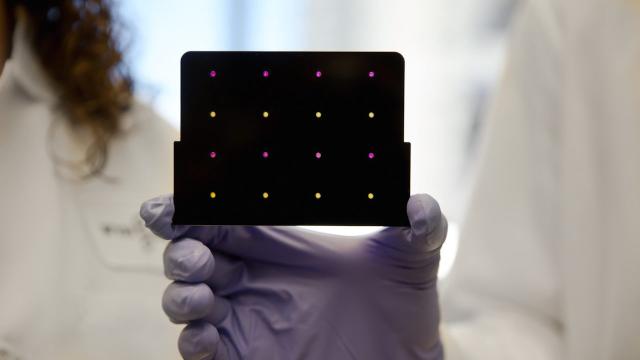The gene editing tool CRISPR could one day mean that we can simply edit away disease, blight and undesirable genetic traits. Now, it’s also gaining traction in another realm of medical technology: Diagnosing disease.
A diagnostic test for detecting Zika with CRISPR. Image: Wyss Institute
On Thursday, researchers at UC Berkeley announced that they have discovered 10 new CRISPR enzymes that can potentially be used to diagnose diseases like Zika or dengue fever quickly and cheaply. The technology isn’t ready for prime-time yet, but it could eventually allow clinics to test a sample of someone’s blood, saliva or urine for many diseases at once.
Typically, when people talk about CRISPR, they are actually talking about CRISPR-Cas9. That’s the CRISPR programming paired with one specific enzyme (Cas9) that’s used to edit DNA at precise locations. But there are a host of other enzymes out there that can be used as part of the CRISPR system, and all of them have different talents. The new enzymes that Berkeley researchers have discovered are all variants of the CRISPR protein Cas13a, and their speciality seems to be detecting specific sequences of RNA, including those from a virus.
In genetic engineering, CRISPR is used to home in precisely on a specific piece of DNA, cut it, and put it back together with the desired genetic code. Here, the same principle is at work. Only instead of sending CRISPR to sniff out a specific piece of DNA, it hunts for RNA — the carbon copy of DNA used to make proteins — associated with a specific virus present in someone’s blood, urine, saliva or other bodily fluid contains. And if CRISPR detects the genetic markers of a pathogen, it can let researchers know by fluorescing. No glow means no virus.
“This method would be fantastic for cheap, point-of-care initial testing,” said Alexandra East-Seletsky, the lead author on the study in Molecular Cell and a post-doc in the Berkeley lab of Jennifer Doudna, one of the scientists who initially discovered CRISPR. “The power of the system is flexibility and speed for targeting new sequences, making it ideal for use during an infectious disease outbreak, or other systems requiring fast development.”
The work piggy backs off earlier work by both Berkeley and the Broad Institute. In September, Berkeley researchers reported the discovery of Cas13a and its ability to detected specific sequences of RNA. Last month, the Broad Institute reported that it had used Cas13a to develop a diagnostic tool that could detect Zika and other viruses. At the time, they said that their technique was not only small and portable, but could cost as little as 61 cents ($0.82) per test in the field. Such a tool might detect viral and bacterial diseases, as well as potentially cancer-causing mutations.
The new work essentially expands the tools available in the toolbox, allowing the CRISPR systems to detect more than one thing at once.
“It allows you to test a control substrate and an unknown at the same time, or look for multiple disease-related sequences at once using the same starting material,” said East-Seletsky. “The possibilities are endless.”
Developing cheap, bedside disease detection is a sort of Holy Grail of medicine. CRISPR’s potential role here has received considerably less attention than its ability to edit genes, but it could wind up being equally significant.
Still, East-Seletsky said, Thursday’s study is just a proof of concept. There is yet a lot of work to be done before there is actually a CRISPR-based diagnostic tool available to clinics.
